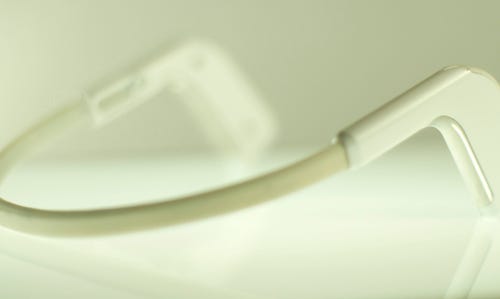Here Comes A Sensor to Read Brainwaves And Train You to Control Your Thoughts
A Canadian startup aims to commercialize a brain-sensing headband to help reduce stress and one day even address epilepsy and ADD.
April 11, 2013
There is a sensor out there for everything you can imagine—to monitor your sleep, heart rate, activity level, and even when and where you are using your asthma inhaler.
The quantified-self movement is no longer an abstraction. And yet, there aren't many sensors out there that can read brainwaves.
|
Ariel Garten, founder and CEO of InteraXon |
But Ariel Garten, 33, founder and CEO of InteraXon Inc., a Toronto startup, is determined to change that. She has developed the Muse headband, a four-channel, six-sensor (four of them are reading sensors) device that aims to not only increase understanding of the brain but also improve memory, reduce stress, and better manage conditions like attention deficit disorder (ADD), epilepsy, and Alzheimer’s.
Garten was a speaker at a session at the legendary South by Southwest Conference in Austin, TX, in March, where she talked about the technology, derived from the University of Toronto. It was initially used in artistic applications—for instance, enabling 48 attendees to a musical conference in Ontario to control the musical output of live computerized jazz players. An installation of the technology at the 2010 Olympics allowed average people to manipulate their thoughts to control lights on Niagara Falls and other Canadian icons from thousands of miles away.
But Garten, who founded InteraXon in 2007, is now looking at the health and wellness space. Due to limited funds, she has focused on a consumer application of the technology but says she hopes to get regulatory approval in the United States to see clinical applications of Muse someday.
That first application is the brain health app, which trains users wearing the Muse headband to improve cognitive function and reduce stress, Garten says. The Muse headband uses dry sensor technology to obtain a near-clinical-grade EEG. By reading the brainwaves, the device can transfer the information to an Android or Apple device.
If reading raw brain waves intimidates you, fear not. The Muse headband, available to ship late this year for $199, is designed for the uninitiated.
|
The Muse brain-sensing headband |
“Nobody ever needs to even be able read the readings because we have very consumer-friendly symbology that takes you through the experience,” Garten explains. “So for instance, if you are doing a focus training task, you can just see a bulb that gets bigger when you are focused and smaller when you are not.”
That is powerful for people trying to improve concentration because there is a visual cue showing them when their mind is wandering.
But Garten has bolder goals for the Muse technology. She says a study showed that only 20 hours of training on this type of EEG technology have been proven to be as effective as Ritalin in managing ADD. She hopes to develop the same tools using Muse to help epileptic patients, children with ADD and ultimately people with Alzheimer’s.
So far InteraXon has raised $1 million from angels and a venture capital firm, ff Venture Capital (New York City). Those goals will need a bigger infusion of cash, and Garten is currently looking to raise $5 million.
Judging by the reaction to the audience at South by Southwest, venture capitalists will be intrigued at the very least.
-- By Arundhati Parmar, Senior Editor, MD+DI
Related Content
The History of the Proteus Ingestible Sensor
Wearable and Implantable Sensors Use Less Power
You May Also Like




